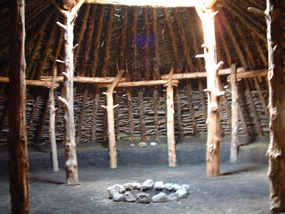
Interior of a Ponca earthlodge. Photo Credit: Linda Gordon Rokosz, National Park Service
The Central Plains Tradition (A.D. 900 – 1450) may have grown out of the Plains Woodland Tradition, or possibly resulted from the migration of new people into the Plains environment. The Central Plains Tradition is primarily recognized along the Missouri, Kansas, and Platte Rivers in Nebraska, Kansas, and western Iowa. Central Plains Tradition people lived in earth-lodge villages, farming corn, beans, squash, and other crops, and hunting with bows and arrows. Participants in the Central Plains Tradition built square houses with rounded corners in relatively small communities. Other commonalities include cord-roughened ceramics, Harahey knives, and certain projectile point styles. During the late 1200s and early 1300s, many western Central Plains Tradition people moved northeast, becoming part of the Coalescent Tradition. Descendants of the Central Plains Tradition villagers include Arikara, Wichita, and Pawnee peoples.
